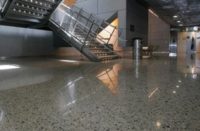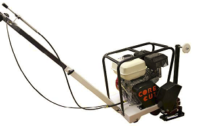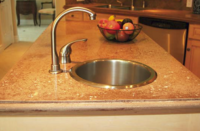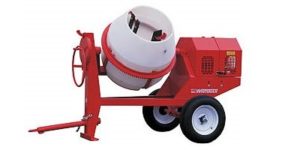
Mobile mixers, sometimes called volumetric mixers or metered concrete, offer a variety of benefits to decorative concrete contractors, including only paying for what is used, eliminating hot loads, readily allowing mix design changes on-site, labor savings, admixture additions and color batching.
Only pay for what’s used
Using a metered concrete truck allows decorative concrete contractors to save money because they only pay for what’s used compared to what’s ordered. And that can add up considering the average price of a yard is about $150 depending on the color.
Many contractors order an extra yard of colored concrete for each job because there are not too many things worse than being short when placing colored concrete. Over a year, that total can be considerable. According to Jeff Bishop of Pleasure Pools in Nashville, Tennessee, he has saved around $15,000 per year by switching to mobile mixers because he doesn’t have to pay for extra concrete to cover pours.
No hot loads
Since concrete from a mobile mixer is mixed on-site, there’s no concern of hot loads from either traffic delays, wrong directions, miscommunication or other issues. When a ready-mix truck arrives an hour or so late, how many times have we asked ourselves, “Wonder how long that’s been cooking?”
Flexible mix designs
Changing your mix with a mobile mixer is as easy as turning a switch or control dial. Gone are the days of “what you got is what you get.” Simply put, pouring colored concrete with a mobile mixer or volumetric mixer gives the decorative concrete contractor more control.
Take Josh Cunningham, owner of C4 Concrete Designs out of Edmond, Oklahoma, for instance. In 2017, he realized this flexibility with mix designs while conducting a stamped concrete demo.
“We had the stamps picked out for this demo and all of a sudden the students wanted a really deep textured stamp to be shown,” he says. “I simply asked the driver (who is also the batch man) to back off the large aggregate by 20 percent.” He said it was no problem.
“Using that deep of a texture with a lot of big rock could have led to tearing my surface,” Cunningham says. The problem was avoided because the aggregate content was easily altered on-site.
Labor savings
In today’s skilled labor-starved environment, smart contractors are learning and adapting to doing things differently. With mobile mixers, companies are placing more concrete with less workers.
I must admit the first time I saw two guys pouring out 1,100 square feet of colored concrete from a mobile mixer to be stamped it seemed to break every “rule” of pouring I was ever taught. Those two guys did a wonderful job, and after two decades in decorative concrete I was learning a very different and perhaps a better way to place and stamp concrete.
Nathan McDaniel out of Bowling Green, Kentucky, owns and operates McDaniel Concrete, a two-man company that exclusively uses mobile mixers. He contends that since mobile mixers only batch on-site seconds before placement, he can control or step-retard his pours with less labor.
“If I’m pouring, say, 800 square feet of colored concrete to be stamped, I’ll often pour out a third and take a small 10- to 15-minute break,” he says, pointing out it’s only a two-man crew doing the job. “I’ll place the second third and take another break and maybe even wet the subgrade on the last third. Then I’ll go back to bull float what I’ve already poured before placing the rest.”
This method allows him to control the set and place more with just a two-man crew. “Now that color is controllable and predictable with mobile mixers, I can charge more and get better margins,” he says. “And I don’t have to play ‘the please come to work today’ game that comes along with multiple employees.”

Admixtures
Today’s mobile mixers are a virtual batch plant on wheels. Admixtures, whether plasticizers (water reducers), chloride accelerators, fibers or non-chloride accelerators, are on the truck and can be used on-site depending on the situation.
This flexibility gives the decorative concrete contractor more control.
Color matching
Bulldog Concrete out of Poughquag, New York, recently added a color machine to one of its mobile mixer trucks. Bulldog’s owner, Rich Colesanti, says he’s seeing an increase in the demand for colored concrete from his decorative customers because many more are confident that mobile mixers can deliver precise color matching whether it’s 1 yard or 15.
Dennis Cooper from Valley Ridge Concrete in Franklin, Kentucky, adds that there’s more precision with colored concrete today because advances have been made in mobile mixers’ color delivery systems. In particular, he notes, today’s machines allow color to be precisely controlled as concrete is mixed.
With a normal tumbler ready-mix truck, a certain amount of color must be spent coating the drum. So when you order 3 yards versus 9 yards, a greater percentage of the color goes to coating the drum, he says. This can easily lead to color discrepancies.
Cooper explains with a mobile mixer, only about a wheelbarrow’s amount of concrete is mixed at a time and you can precisely control the color from 1 yard to however many yards. This control of color is crucial to the success of a decorative concrete contractor.
Future outlook
According to Jerry Stoner, president of Zimmerman Industries, a driving force within the mobile concrete industry that’s headquartered in Ephrata, Pennsylvania, the future for mobile mixers looks pretty rosy.
“About 75 percent of Zimmerman’s new truck sales are going to concrete contractors to provide their own concrete,” he says. “Labor shortages, flexibility, control and the ability to deliver their own colored concrete is why many decorative concrete contractors can benefit from pouring colored concrete with mobile mixers.”















